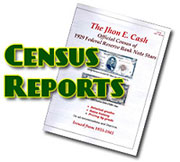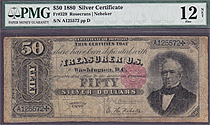| Large Size Silver Certificates $50 Fr-323 to Fr-335 During the Civil War, both the North as well as the South developed their own currency. Ripped apart by war and teetering on bankruptcy, Congress ordered the printing of a number of notes. These Large Size Notes were commonly called horse blankets because of their dimensions. Issued from 1861 to 1928, their original size was approximately 7.42 inches by 3.13 inches. Cost cutting measures have reduced todays note to the more familiar 6.14 inches by 2.61 inches. Demand Notes or Greenbacks minted only in 1861 represent Americas first type of Federal Bank money. All notes that was printed and issued to the public is still legal tender today and can be redeemed to any bank for face value. They exception is the 1900 $10,000 gold certificate that was tossed out of a window during a fire in 1936. They were punched cancelled and therefor have no face value for redemption except for collectors. Large Size-Silver Certificates
Acts of Congress dated Feb. 28, 1878, and Aug. 4, 1886 authorized the Large-Size Silver Certificates. There were five issues from Series 1878 to Series 1923.
- The first issue, Series 1878 and 1880, consisted of $10, $20, $50, $100, $500 and $1,000 denominations. The face side states that "There have been deposited with the Treasurer of the United States at Washington, D.C. payable at his office to the bearer on demand ... Silver Dollars." "Certificate of Deposit" is inscribed on the notes. All certificates of the 1878 series and one of the notes in the 1880 series are countersigned by assistant treasurers of the United States at New York and bear the signatures of G.W. Scofield and James Gilfillan.
- The second issue of Silver Certificates consists of Series 1886, 1891 and 1908. The 1886 series was printed in denominations of $1, $2, $5, $10 and $20. The 1891 series includes these, but added denominations of $50, $100 and $1,000. Only the $10 note was issued in Series 1908. On the face of Series 1886, 1891 and 1908 notes appears the wording "This certifies that there have been deposited in the Treasury of the United States ... Silver Dollars payable to the Bearer on Demand."
- The third issue of Silver Certificates, Series 1896, is one of the most popular and deemed by collectors as the most beautiful series ever produced by the United States. Titled the "Educational Series," the notes were designed or redesigned by Thomas F. Morris, designer and chief of the Engraving Division of the Bureau of Engraving and Printing. Other designers of this famed series were Will H. Low, $1, Edwin H. Blashfield, $2, and Walter Shirlaw $5. Known engravers of the series were Charles Schlecht and George F.C. Smillie.
- The fourth issue, Series 1899, was released in three denominations, $1 (The Black Eagle), $2 (The Agriculture Note) and $5 (The Chief Note). The face design of the $1 features the American Eagle with portraits of Lincoln and Grant. The $2 note portrays Washington between figures representing Mechanics and Agriculture, and the $5 note features Ta-to-ka-in-yan-ka, Running Antelope, a Sioux Indian. George F.C. Smillie engraved the design in November of 1899.
- The fifth issue of Silver Certificates, Series 1923, consists of two denominations, $1 and $5. Washington is portrayed on the $1 and Lincoln on the $5. On the latter note, Lincoln is shown in the center of a circular design and therefore this note is sometimes called the "Porthole" note.
Home - Currency Home -
Coins Home - About Us -
Account Log-In - FAQs -
Want Lists - News/Blogs -
Currency Census -
Terms & Conditions |
























































